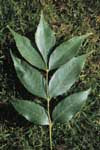 |
 |
 |
|
A green ash Courtesy G. Lumis |
Leaf of a green ash Courtesy G. Lumis |
Bark of green ash Courtesy G. Lumis |
Scientific Name: Fraxinus pennsylvanica
Summary
Foliage: Deciduous broadleaf
Height: 50 to 60 feet
Spread: 20 to 30 feet
Shape: Spreading
Glossy, green, summer foliage turns yellow in fall, but drop too quickly to provide effective color. Green Ash develops a broad crown with age.
Plant Needs
Zone: 3 to 9
Light: Full sun
Moisture: Wet, moist, or dry
Soil Type: Sandy, loam, or clay
pH Range: 3.7 to 7.0
Functions
Suggested uses for this plant include shade, street tree, and specimen plant.
Planting Notes
Transplants readily and is very adaptable. Plant in full sun. Tolerates wide range of soil conditions. Once established, tolerates high pH, salt, drought, and sterile soils. Select seedless varieties to avoid litter problem from fruit-bearing trees.
Care
When required, prune in the fall. Prune dead twigs and branches anytime.
Click here to learn how to improve the soil.
Problem
Problems include canker and dieback, which result in dead wood. Borers can be a serious pest when plant is young. Seedlings can become a problem in flower beds and other unwanted areas.
Alternatives
Consult local sources, including historic or public gardens and arboreta, regarding cultivars and related species that grow well in your area.
Cultivars of FRAXINUS PENNSYLVANICA
`Marshall's Seedless' is a male clone which forms an upright, oval shape.
`Honeyshade' is a handsome, seedless type with glossy, green foliage. It does not look like a Green Ash.
`Summit' is a male tree with upright, pyramidal growth and smaller leaflets.
Comments
Green Ash is a vigorous tree while young and is a popular tree because of its adaptability.
This material was developed by Carol Ness as part of the Interactive Design and Development Project funded by the Kellogg Foundation. Mary Miller, Project Director. Diane Relf, Content Specialist, Horticulture. Copyright 1989 by VCE.

